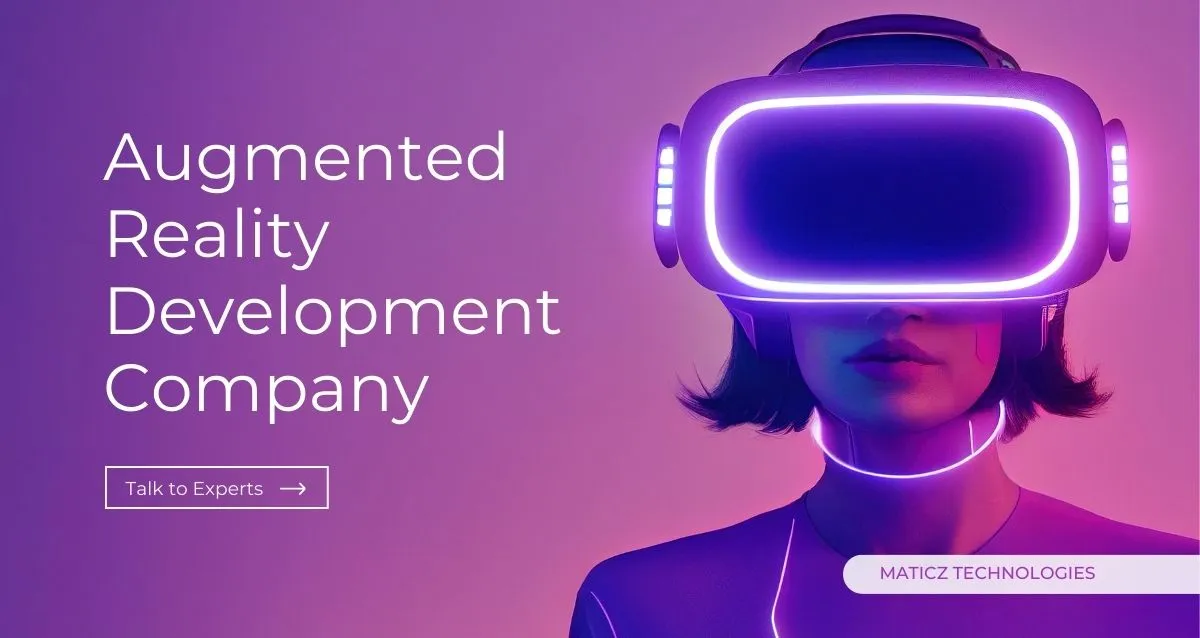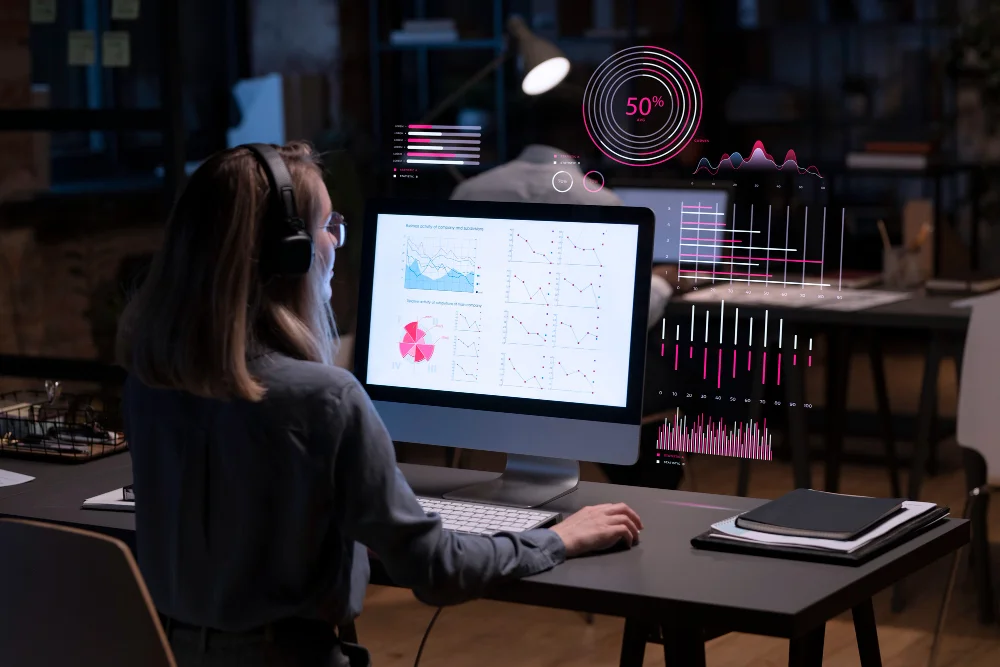Share Posts

Augmented Reality Development Company
46
3795
103
Collaborate with an industry-leading Augmented Reality development company that serves as a strategic partner for businesses seeking to unlock the full potential of Augmented Reality and pioneer the future of immersive technology.
Augmented Reality: Unleashing a Myriad of Opportunities for Business Transformation
Augmented Reality has become a transformative force in the current era shaped by technological progress. The increasing demand for augmented reality solutions goes beyond being a temporary trend. It has a significant impact on businesses in various sectors. Whether in retail, e-commerce, or marketing, AR provides engaging experiences that capture the attention of consumers, fostering brand loyalty and increasing conversion rates.
In industries like manufacturing, healthcare, and aviation, AR applications offer practical and interactive training opportunities. Businesses benefit from improved training efficiency and a decrease in operational risks, ranging from simulated equipment maintenance to practicing medical procedures.
From enhancing customer engagement to revolutionizing industries, augmented reality opens up many opportunities. As businesses adopt AR to bring in new ideas, set themselves apart, and stay competitive, it becomes clear that augmented reality is more than just a technology. It's a strategic tool that enables business growth and success in the digital age.
AR App Development Company
AR App Development is the process of making applications that use augmented reality technology. It plays a crucial role in the ongoing technological revolution by connecting the physical and digital worlds. This development involves creating apps that improve real-world experiences by adding graphics or 3D models to the physical environment. Usually, users view these enhancements through devices like smartphones, tablets, or AR glasses.
Maticz stands out as a leading AR app development company, renowned for its creative and effective AR applications. Our team of skilled professionals specializes in AR technologies, frameworks, and best practices. We offer a range of AR app development services, including UI/UX design, programming, 3D modeling, and integration with backend systems.
We guide clients through a well-thought-out process, providing customized and impactful AR development. Our experts use advanced programming languages and AR frameworks to build applications that fully utilize AR technology, ensuring compatibility across different platforms and incorporating cutting-edge features.
Why Invest in AR App Development?
More and more businesses and investors are getting excited about using augmented reality (AR). The numbers show how AR technology is making big changes and creating lots of opportunities in different industries. The following statistics surrounding AR adoption, market size, and revenue projections give a clear picture of how big the potential is for making AR apps.
1. By 2024, an estimated 1.7 billion mobile augmented reality users are expected worldwide, showcasing a remarkable rise from the 200 million users recorded in 2015.
2. Consumers globally recognize AR as the most disruptive emerging technology, surpassing even Artificial Intelligence (AI).
3. The global augmented reality market was valued at USD 57.26 billion in 2023, with a projected compound annual growth rate (CAGR) of 39.8% from 2023 to 2030.
4. The global virtual fitting room market is forecasted to witness substantial growth, reaching an estimated USD 18.31 billion by 2030.
5. Approximately 75% of the global population, and almost 100% of smartphone users, are expected to become frequent AR users by 2025.
6. Businesses leveraging AR technology experience a significant boost, with conversion rates found to be 40% higher compared to traditional methods.
7. AR revenue is projected to exceed a staggering $50 billion by 2027.
8. By 2028, total revenue from the AR & VR space is set to increase nearly 2x.
9. The AR space is anticipated to grow at a compound annual growth rate (CAGR) of approximately 41.5%, reaching a market size of $461.25 billion by 2030.
10. A 2022 Grand Research report indicates that the Global AR software market, valued at around USD 8.58 billion in 2020, may reach a remarkable $137.14 billion by 2028.
Our Augmented Reality Services
Our Augmented Reality Services offer various options to help businesses make the most of this powerful technology. From planning to putting it into action and providing ongoing assistance, these services are vital for creating immersive and exciting AR experiences. Let's take a closer look at our innovative Augmented Reality Services.
AR Consultation and Strategy
Expert consultants engage in detailed discussions and analyze business and industry needs to create a personalized AR strategy. This involves identifying possible uses, defining project scopes, and outlining a plan to make sure the implementation is strategic and effective.
AR App Design
Designers focus on creating visually appealing and user-friendly interfaces that smoothly combine virtual elements with the real world. From planning the layout to making prototypes, AR App Design ensures that users find the experience easy, engaging, and in line with the overall vision of the application.
AR App Development
Skilled AI developers use programming languages and AR frameworks to build applications that make virtual elements come to life. Whether it's marker-based AR, markerless AR, or a mixed reality experience, the development phase ensures the best performance, responsiveness, and compatibility across different platforms.
AR Integration Services
AR integration services connect AR applications with databases, APIs, and other technologies to ensure real-time data synchronization. Whether used in retail, manufacturing, healthcare, or education, AR integration ensures that the technology fits the specific needs and processes of the business.
AR App Support and Maintenance
Beyond the initial launch, AR app support and maintenance services make sure AR applications continue to work well and stay relevant. This involves regular updates, fixing bugs, and making improvements to keep up with changes in hardware and software standards.
Industry-Specific Augmented Reality Solutions
Augmented Reality (AR) has evolved far beyond just enhancing our reality and become a versatile tool across various domains. Let's delve into our industry-specific AR solutions that are pushing the boundaries of innovation.
Visual Recognition Solutions
AR apps with visual recognition abilities can identify objects, images, and scenes, improving user experiences. From translating text instantly to recognizing landmarks, visual recognition in AR offers many possibilities for seamlessly combining the digital and physical worlds.
Face and Gesture Recognition Platforms
Face and gesture recognition in AR brings a new level of interaction. These platforms use facial and gesture cues to understand user inputs, enabling intuitive and hands-free interactions. This especially makes controlling devices hands-free more accessible and user-friendly.
Sensor-based AR Apps
Sensor-based AR apps use various sensors like GPS, accelerometers, and gyroscopes to enhance the accuracy and responsiveness of AR experiences. This enables location-based AR applications, creating context-aware and dynamic content that adapts to the user's surroundings.
Web AR Apps
Users can experience AR directly through Web AR apps without needing to install additional apps. This reduces barriers to entry, making AR experiences more widely available across devices, from smartphones to tablets and desktops.
Augmented Reality Games
Augmented reality games blend the virtual and physical worlds, providing users with immersive gaming experiences in their actual environment. These games often involve interactive elements like collecting virtual objects in real spaces or battling digital creatures overlaid on the user's surroundings.
Augmented Product Configurators
Augmented product configurators allow users to see and customize products in real-time, from choosing colors and textures to adjusting dimensions. This improves the shopping experience and empowers customers to make informed purchasing decisions.
AR Visualization Solutions
AR visualization involves overlaying dynamic and interactive digital information onto the physical world. From architectural visualizations and design prototyping to interactive museum exhibits, AR visualization solutions provide a richer and more engaging way to convey information.
Training and Development Modules
Simulation-based AR training modules allow users to practice and learn in realistic environments without real-world consequences. From medical procedures to complex machinery operations, AR training modules enhance skill acquisition in a safe and controlled setting.
3D Object Tracking
3D object tracking in AR involves precisely tracking the movements and positions of physical objects in real time. This solution is instrumental in industrial applications, such as maintenance and assembly, where precise object tracking ensures an accurate overlay of digital information onto physical objects.
Diverse Types of AR Apps We Develop
We develop a range of Augmented Reality (AR) applications that cater to different user needs and industry requirements. Let's take a look at the various types of AR apps we develop.
Marker-Based AR
Marker-based AR relies on markers or images that are predefined to activate augmented content. When the camera on the device recognizes these markers, it superimposes digital information or objects on top of them. It is commonly used in print media, packaging, and educational materials.
Marker Less AR
Unlike marker-based AR, markerless AR does not require predefined markers. Instead, it uses the device's sensors, such as GPS, accelerometers, and cameras, to anchor digital content to the user's real-world environment. Markerless AR is well-suited for dynamic and location-specific experiences.
Location-Based AR
Location-based AR applications use GPS and other location data to deliver contextually relevant content based on the user's geographical position. Navigation apps, tourism guides, and games that incorporate real-world maps commonly utilize this type of AR.
Projection-Based AR
Projection-based AR involves projecting digital content onto physical surfaces in the real world. This can be achieved through devices like smart projectors or AR glasses. Projection-based AR is used in various applications, from interactive displays in retail to immersive presentations.
Superimposition AR
Superimposition AR involves overlaying digital information directly onto the user's view of the real world. This type of AR is often associated with applications that enhance visual perception or provide additional information about physical objects.
Web AR
Web-based AR, or WebAR, allows for augmented reality experiences to be brought directly to web browsers, eliminating the need for users to download dedicated apps. It allows users to experience AR content through their device's browser seamlessly. WebAR is gaining traction in marketing, education, and interactive web experiences.
AR App Development For Various Industries
Augmented Reality (AR) app development is reshaping industries by introducing innovative solutions Let's explore various industries for which we deliver AR development services.
Healthcare
AR development in healthcare focuses on applications like surgical navigation, medical training, and patient education. Surgeons use AR for precise visualization during procedures, while medical students benefit from interactive 3D models for learning. Patient engagement is improved through AR apps that provide detailed information about medical conditions in a visual and accessible format.
E-commerce
AR in e-commerce development is transforming the way consumers shop online. Augmented reality try-on experiences allow customers to virtually try out products like clothing, accessories, and furniture before making a purchase. Product visualization apps provide an immersive shopping experience, reducing returns and boosting customer confidence.
Education
AR development in education introduces interactive and engaging learning experiences. Educational AR apps bring textbooks to life with 3D models, animations, and simulations. Virtual field trips, historical reconstructions, and interactive lessons create a dynamic learning environment, catering to various learning styles.
Real Estate
AR development is revolutionizing the real estate industry by offering virtual property tours and visualizations. AR apps enable potential buyers to explore properties in a detailed and interactive manner, overlaying information such as floor plans and property details. This not only enhances the buying process but also accelerates decision-making.
Manufacturing
In manufacturing, AR development focuses on improving efficiency and reducing errors. AR-powered smart glasses provide real-time instructions to workers during assembly, maintenance, and quality control processes—3D visualizations aid in design and prototyping, ensuring accurate production outcomes.
Supply Chain and Logistics
AR development in supply chain and logistics optimizes operations by providing real-time information. AR apps assist warehouse workers in locating and picking items more efficiently. In transportation, AR enhances route planning, vehicle maintenance, and navigation, contributing to a smoother logistics process.
Entertainment
Augmented reality games create immersive and interactive experiences, blurring the lines between the digital and physical worlds. AR-enhanced live events, interactive exhibits, and location-based experiences redefine entertainment engagement.
Marketing and Advertisement
AR development is revolutionizing marketing campaigns by creating interactive and memorable experiences. AR ads engage users with virtual try-ons, interactive product demonstrations, and gamified experiences. Marketers use AR to enhance brand interaction, drive customer engagement, and create memorable brand experiences.
Benefits of Augmented Reality Development
As businesses and sectors increasingly integrate AR into their strategies, the benefits are becoming more evident. Let's delve into the diverse advantages of Augmented reality development across different domains.
Marketing Edge
AR provides a unique and immersive marketing edge, enabling businesses to create interactive and memorable campaigns. Augmented reality ads, product visualizations, and virtual try-ons captivate audiences, setting brands apart in the competitive market.
Improved User Engagement
AR development enhances user engagement by offering interactive and personalized experiences. Whether it's a gaming app, a virtual try-on in e-commerce, or an educational AR module, the interactive nature of AR captivates users, encouraging prolonged interactions.
Industrial Training and Maintenance
AR-powered training modules allow workers to simulate complex tasks in a controlled environment, reducing the learning curve and minimizing errors. Maintenance procedures benefit from AR overlays that provide real-time information, ensuring efficient and accurate execution.
Higher Conversions
Virtual try-on features allow customers to visualize products in their own space before purchasing, reducing uncertainty and boosting confidence in their buying decisions. The immersive and personalized nature of AR experiences often leads to increased conversion rates.
Reduced Language Barriers
Language-agnostic visualizations, such as AR language translation apps, enable users to understand and interact with information in their preferred language. This is particularly valuable in diverse global markets, fostering inclusivity and expanding accessibility.
Data Visualization
Augmented reality development excels in data visualization, transforming complex information into visually intuitive displays. In sectors like finance, healthcare, and logistics, AR enables users to interact with and comprehend large datasets in a more digestible manner.
Teckstack For AR Development
Being one of the leading Augmented Reality development companies, we always use the most up-to-date technologies and frameworks to deliver futuristic AR services and solutions.
ARKit
ARCore
Unity
Vuforio
Wikitude
XCode
Android Studios
Microsoft HoloLens
Our Step-by-Step AR Development Process
The development of Augmented Reality (AR) applications requires a systematic and well-structured process to ensure successful implementation. Here is our comprehensive guide to the AR development process, from the initial stages of requirement gathering to the final deployment and maintenance.
Requirement Gathering
The first step in AR development is to understand the client's needs and project goals. This involves detailed discussions with stakeholders to gather information about the target audience, intended user experience, and specific functionalities required.
Concept Design
Once requirements are gathered, the development team works on conceptualizing the AR application. This involves brainstorming ideas, sketching preliminary designs, and creating a conceptual framework for how the AR elements will interact with the real world.
Decide on Features and Functionalities
Based on the concept design, the team collaborates with stakeholders to decide on the features and functionalities of the AR application. This stage involves prioritizing essential elements, determining user interactions, and defining the scope of the project.
Create Prototype and MVP
The next step is to create a prototype or Minimum Viable Product (MVP) of the AR application. This provides a tangible representation of the design and functionality, allowing stakeholders to visualize the end product.
Visual and Technical Design
With a validated prototype, the development team moves on to the visual and technical design phase. Visual design involves creating the user interface, incorporating branding elements, and ensuring a seamless user experience. Simultaneously, technical design focuses on defining the architecture, selecting technologies, and establishing the development environment.
Development
The actual coding and development of the AR application commence at this stage. The development team follows the specifications outlined in the prototype and technical design, ensuring that the application aligns with the agreed-upon features and functionalities.
AR Integration
AR development involves integrating augmented reality functionalities into the application. This includes incorporating features such as object recognition, tracking, and overlaying digital content onto the real world.
Testing and Debugging
Rigorous testing is conducted to identify and address any bugs or issues within the AR application. Debugging ensures that the application meets quality standards and functions seamlessly across various devices and platforms.
Deployment and Maintenance
Once testing is successful, the AR application is ready for deployment. This involves making the application available to users through app stores or other distribution channels. Post-deployment involves ongoing maintenance to address emerging issues, ensure compatibility with new devices and operating system updates, and implement additional features or improvements.
Hire AR Developers
If you are looking for the right talents to transform your innovative AR ideas into reality, Maticz is the best place to find and hire top-tier AR developers. We have a team of highly skilled developers with unparalleled expertise in AR frameworks and technologies. From Unity to ARKit, ARCore, Vuforia, and beyond, our developers are well-versed in the tools that power innovative AR experiences. With a robust portfolio of successful AR projects, Maticz has a proven track record of delivering high-quality and impactful solutions.
Whether you're looking to develop a branded AR app, enhance your marketing campaigns, or integrate AR features into existing platforms, our developers tailor their expertise to meet your individual needs. Our developers work closely with clients to understand their unique requirements, provide assistance at every stage of the project, and ensure the successful delivery of high-quality AR solutions. Join hands with Maticz and elevate your AR projects to new heights.
What Makes Maticz The Top AR Development Company?
Maticz is a top AR development company known for its unwavering commitment to delivering innovative AR solutions. From the initial consultation to project completion, clients experience clear communication regarding project timelines and costs. Whether it's creating immersive brand experiences, interactive educational modules, or innovative marketing campaigns, we ensure that each AR app is a bespoke solution that aligns with the client's vision.
We stay abreast of the latest technologies, trends, and emerging possibilities within the augmented reality landscape. We keep clients informed at every stage, seeking feedback and ensuring alignment with project goals. With a focus on transparency, personalized design, end-to-end security, and dedicated assistance, Maticz not only delivers cutting-edge AR solutions but also establishes enduring partnerships with clients.
Tap Into the Future
The latest insights, posts, and project updates - straight to your inbox.




